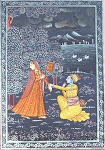In the beginning of Kamasutra, Vatsyayan clearly says that the earlier matter on this delicate topic was available in pieces and the compilation if Babhrav was too huge to be understood by common people. Hence, he compiled this abridged version so that everybody could easily and thoroughly understand this subject.
SUBSTANTIVE MATTER OF KAMASUTRA
Substantive collection of matters has been done in the first part of Kamasutra. This matter includes Dharma (religion), Arth (wealth) and Kama (Carnal pleasures). First part also discusses about the ways to achieve this substantive matter. Matter of Kamasutra also includes the time of studying Kamasutra, sixty-four postures, singing and playing instruments the agents of men and women folk proficient in this art, and the partners in intercourse.
AUTHENTICITY OF KAMA SHASTRA
Maharshi Vatsyayan regards Kamashastra as authentic as other religious scriptures. He says: ‘After creating the subjects, Lord Brahma first of all preached Trivarga (Dharma, Artha and Kama). Dharma or religion leads to fortune in this world and in the another. Arth or wealth helps a man to collect the means of comforts and live a religious life. With Kama or Carnal pleasure, a person makes his life happy. Moreover, without a woman and children, a man has no reputation in society.
Without abandoning Adharma, no one can get Dharma. Hence in the one lakh chapters of Vedas, Brahmaji dictate about the measures how to attain Dharma, Arth and Kama. Later on, Manu separated and compiled the measures to attain Dharma, while Brihaspati separated and compiled the measures to attain Arth. Measures to attain Kama were separated and compiled by Nandi. These one thousand chapters, that comprise Kamasutra and were separated and compiled by Nandi, the vehicle of Lord Shiva, were later on abridged form of five hundred chapters by Shvetketu, the son of Maharshi Uchhalaka. Later on, Panchal, the son of sage Vabhru (also referred to as Babhrav by the preceptor) concised those five hundred chapters into one hundred and fifty.
KAMASUTRA IS NOT OBSCENE
Many gentlemen accuse Kamasutra of rendering the whole literature obscene. Refuting these accusations only our things can said that there are two ways of expressing anything – sober and slang. Intricate and intimate relation between a man and a woman will be said to be obscene if expressed in slang terms before the noble ladies. In sober term however, this relationship will not appear obscene at all. A sober language presents even the most obscene subject in a well decorated manner. Such a description doers not induce shame. But incites the curiosity of the reader in a piquant way. Hence, it is a common belief among the litterateurs that infrequent use of words, which may appear obscene otherwise, to describe a romantic scene, must not be mistaken with regularity. Such terms should be regard more as merit than demerit of literature. Moreover, films are the main carriers of spreading vulgarity now days.
While reading a book, one has to strain his mind as well as eyes. But to watch a movie, you have nothing to do except see. More than often after watching a movie, one is compelled to feel if a censor board exists in India. Besides there are so called educative films that cross all the boundaries of sobriety. Nonetheless, Kamasutra is such a substantive subject that even the film makers could not contain themselves and presented Kamasutra on celluloid screen. No critics than termed that film as vulgar.
PARTS OF KAMASUTRA
There are seven parts in Kamasutra. These are: 1) Sadharana (general), Samprayogik, 3) Kanya Samprayuktaka, 4) Bharya dhikarik, 5) Paridarik, 6) Vaishik and 7) Aapamshadik.
1) Sadharna (General): It is basically an introduction to Kamasutra. It contains brief discussion about all the other parts.
2) Samprayogik: It deals with the methodology of Kamasutra. All the matters related to intercourse have been discussed in this part. A knowledge of this part quenches beastly tendencies arising in a man because of a desire to have an intercourse.
3) Kanya Samprayuktak: This part described about the ways like marriage to receive a girl and coaxing her with intercourse. Tradition and kinds of Swayamvar have also been discused.
4) Bharyadhikarik: This part described about how the married women should behave with their husband, and how a married man should behave with his wife and children.
5) Pardarik: Unfortunately, even the married women are not immune to the leers of other men. This part described the ways man adopt in order to establish illicit connection with married women. Its knowledge is a must for all the married men, because only they will be able to guard their wives.
6) Vaishik: Behaviour of prostitutes. This part expose the craftiness prostitutes apply to trap their customers. A proper knowledge of prostitutes behaviour will help gullible people to shun the company of such women.
7) Aupanishadik: This part contains beneficial discussion about mysterious topics. Measures to correct impotency been discussed.
INDEX
Friday, December 7, 2007
Subscribe to:
Posts (Atom)
